Read about the people who represent the Spirit of Ukraine in the second part of TIME’s Person of the Year coverage.
The call from the President’s office came on a Saturday evening: Be ready to go the next day, an aide said, and pack a toothbrush. There were no details about the destination or how we would get there, but it wasn’t difficult to guess. Only two days earlier, on the 260th day of the invasion of Ukraine, the Russians had retreated from the city of Kherson. It was the only regional capital they had managed to seize since the start of the all-out war in February, and the Kremlin had promised it would forever be a part of Russia. Now Kherson was free, and Volodymyr Zelensky wanted to get there as soon as possible.
His bodyguards were urging him to wait. The Russians had destroyed the city’s infrastructure, leaving it with no water, power, or heat. Its outskirts were littered with mines. Government buildings were rigged with trip wires. On the highway to Kherson, an explosion had destroyed a bridge, rendering it impassable. As they fled, the Russians were also suspected of leaving behind agents and saboteurs who could try to ambush the presidential convoy, to assassinate Zelensky or take him hostage. There would be no way to ensure his safety on the central square, where crowds had gathered to celebrate the city’s liberation, within range of Russian artillery.

“My security was 100% against it,” the President told me during the trip. “They took it hard. They can’t control practically anything in a region that has just been de-occupied. So it’s a big risk, and, on my part, a bit reckless.”
Then why do it? The Russian goal at the start of the invasion had been to kill or capture Zelensky and decapitate his government. Why give them a chance to strike? The obvious reason had to do with the information war, which had become Zelensky’s specialty. By rolling into the city that Vladimir Putin still claimed as his own, the leader of Ukraine would blow a hole through the stories of conquest and imperial glory that Russian propagandists had been using for months to justify the war. Zelensky’s visit would deepen the embarrassment of the Russian retreat and strengthen the Ukrainian will to carry on through the winter.
But that was not the reason he gave for the trip. “It’s the people,” he told me in a two-hour interview as his private train rolled through the country. “Nine months they’ve been under occupation, without light, without anything. Yes, they’ve had two days of euphoria over their return to Ukraine. But those two days are over.” Soon the long road to recovery would come into view, and many of his citizens would want a return to normality, much faster than the state can deliver it. “They are going to fall into a depression now, and it will be very hard,” Zelensky explained. “As I see it, it’s my duty to go there and show them that Ukraine has returned, that it supports them. Maybe it will give them enough of a boost to last a few more days. But I’m not sure. I don’t lull myself with such illusions.”
Our rendezvous point for the trip was outside a firehouse, in a part of central Kyiv that was without electricity when the photographer and I arrived the following evening. Russian missiles have damaged or destroyed much of Ukraine’s power grid since the start of October, a concerted effort to make the winter as painful as possible for the civilian population. People out walking their dogs used their phones to light the sidewalks. Even the central bazaar was in darkness, though the vendors inside were still selling fresh fruit and cheese, pickles, and pork belly by the glow of electric lanterns. When we passed them, lugging our bulletproof vests and helmets, we made sure to grab some food for the road. “Bring snacks,” one of Zelensky’s aides had warned in a text message. “These trips tend to be very disorganized.”
You wouldn’t know it from the black van that arrived to pick us up, as agreed, at 7:30 p.m. on the dot, and brought us through the checkpoints that surround the government district. The area had become familiar to me since the start of the invasion. For nearly nine months, Zelensky’s team had allowed me to spend much of my time here, working inside the presidential compound and reporting on the ways they have experienced the war and how it has transformed them—and him. The blackouts gave the place a haunted look. Soldiers peered out of pillboxes hidden among the trees, and flashlight beams flickered in the windows of Zelensky’s office on the fourth floor. “Do you have documents on you?” asked one of the guards. “Good, then we’ll know how to mark your grave if you fall behind the convoy.” The joke made his comrades double over with laughter.
That night, the presidential train took about nine hours to travel the length of Ukraine from north to south. Most of the compartments were taken up by the security men, who rested their assault rifles on the luggage racks, kicked up their feet, and watched movies on their phones. They had never seen reporters on this train before, and their only request was that we not take any photos of Zelensky’s private carriage. “If the Russians find it, that’s a bull’s-eye,” one of them explained.
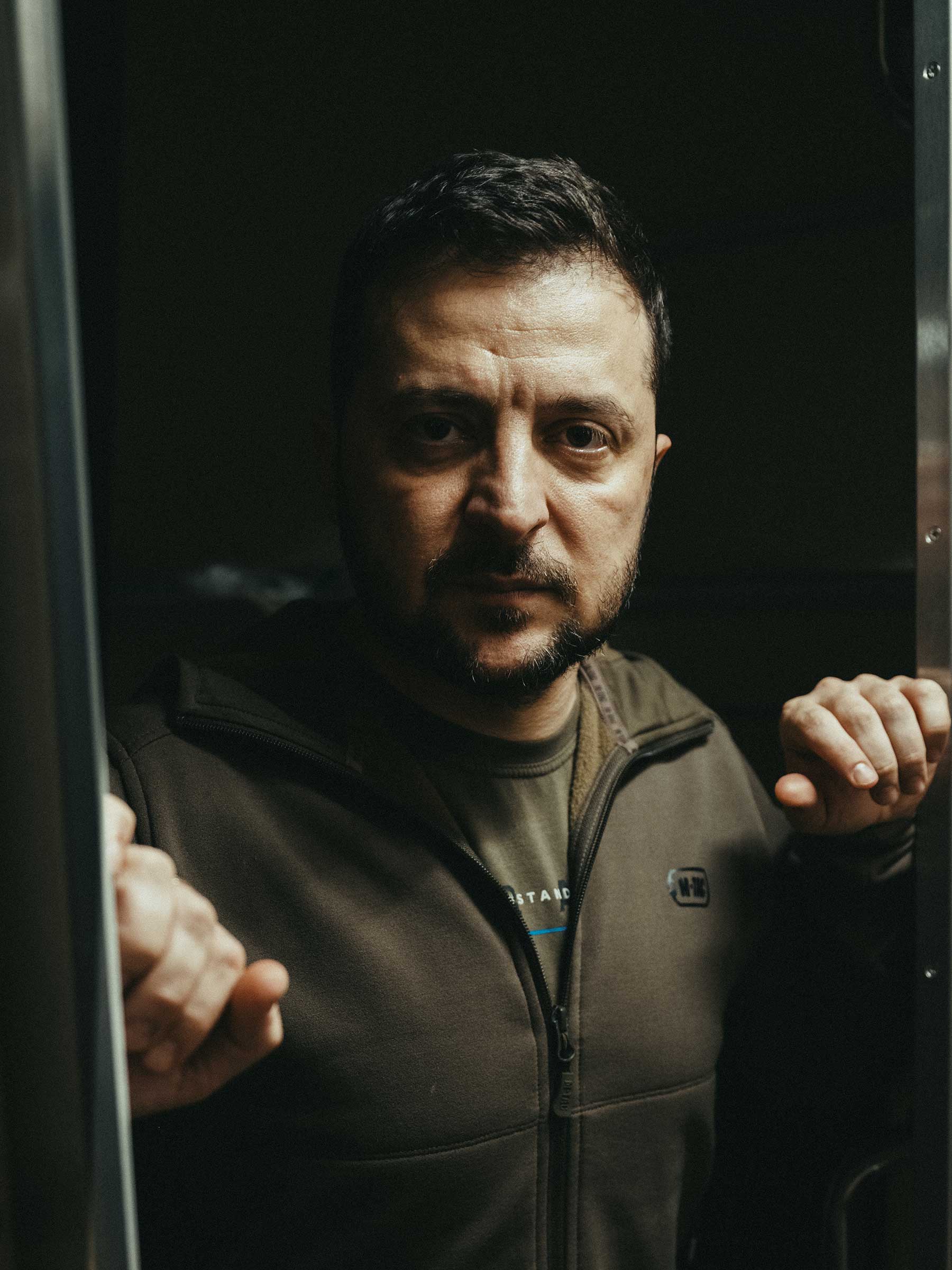
Since the start of the invasion, air traffic over Ukraine has been limited to fighter jets, drones, bombers, and cruise missiles. The train has become the President’s primary means of long-distance travel. From the outside, his carriage is indistinguishable from a regular passenger car. Inside, my expectations of a high-tech command center on wheels, or at least a well-stocked bar, did not pan out. There was no internet on board, and the amenities were modest. A first-class ticket on Amtrak would offer more space to stretch out.
But Zelensky says he enjoys the train. It gives him time to read, and the experience reminds him of his childhood. When he was growing up, his father worked as a systems manager in the copper mines of Mongolia, and the trips to visit him would take eight days on the railroad from their hometown of Kryvyi Rih in central Ukraine, passing all the way through Russia and Siberia. He remembers the journeys fondly—the vast expanses of the Soviet empire rolling by, the glasses of tea served in metal cup holders embossed with the hammer and sickle. It is among the many ironies of his predicament that Zelensky was raised in the empire whose revival he is now fighting to stop.
For most of his life, he felt nostalgia for the culture and history Ukraine shared with Russia. “There were these amazing Soviet comedies,” Zelensky told me. Among his heroes growing up were filmmakers like Leonid Gaidai, whose works were heavily censored but still charming and often hilarious; one depicted Ivan the Terrible swapping lives with a superintendent at a Soviet apartment building. “These are the classics of my generation, but I’m incapable of watching them now,” the President says. “They revolt me.” Memories of his youth are now colored by the atrocities that Russian forces committed this year in service of Moscow’s imperial ambitions.
In April, less than two months into the invasion, Zelensky told me he had aged and changed “from all this wisdom that I never wanted.” Now, half a year later, the transformation was starker. Aides who once saw him as a lightweight now praise his toughness. Slights that might once have upset him now elicit no more than a shrug. Some of his allies miss the old Zelensky, the practical joker with the boyish smile. But they realize he needs to be different now, much harder and deaf to distractions, or else his country might not survive.

Early in the morning, the train came to a stop in an industrial lot in the region of Mykolaiv, where a convoy of vans and SUVs was waiting to drive us the rest of the way to Kherson. The devastation of the war soon appeared on both sides of the highway: bus stops pocked with shrapnel gashes, twisted shells of bombed-out buildings, a family restaurant in the shape of a castle that looked as if it had been strafed with a chain gun. The damage around Mykolaiv was worse than in most of the country, because it was here that the Ukrainians managed to stop the Russian advance from the south in March.
A dozen or so governors, ministers, and generals were waiting on Kherson’s central square when we arrived. They posed and took selfies in front of the graffiti scrawled on the facade of the regional parliament: Glory to the Armed Forces of Ukraine! Glory to the heroes! One of Zelensky’s aides, Dasha Zarivna, grew up in Kherson, and she looked close to tears as she gazed at the Ukrainian flags flying over the square. “I was scared I’d never see this place again,” she told me. “And here we are.”
The first explosion sounded a few minutes later. Everyone froze, looking up at the sky for a shell to come arcing down. Then came another boom, which sounded closer than the first. Someone suggested it was outgoing artillery fire, though this seemed more like an optimistic guess. The Russians had retreated to the left bank of the Dnipro River, about a mile away. The blasts continued to sound, but Zelensky did not seem bothered by them. He declined, as usual, to wear a helmet or bulletproof vest.
At the edge of the square, the soldiers had installed a Starlink Internet terminal, plugging its satellite antenna into a diesel generator. The President took out his phone and asked for the wi-fi password. Most of the people around him were armed with assault rifles, but this was his weapon, a late-model iPhone that Zelensky has used to wage the biggest land war of the information age. His skill at addressing the world through that phone—in his nightly speeches on social media, in his endless calls with foreign leaders and supporters—has been as critical as the number of tanks in his army.
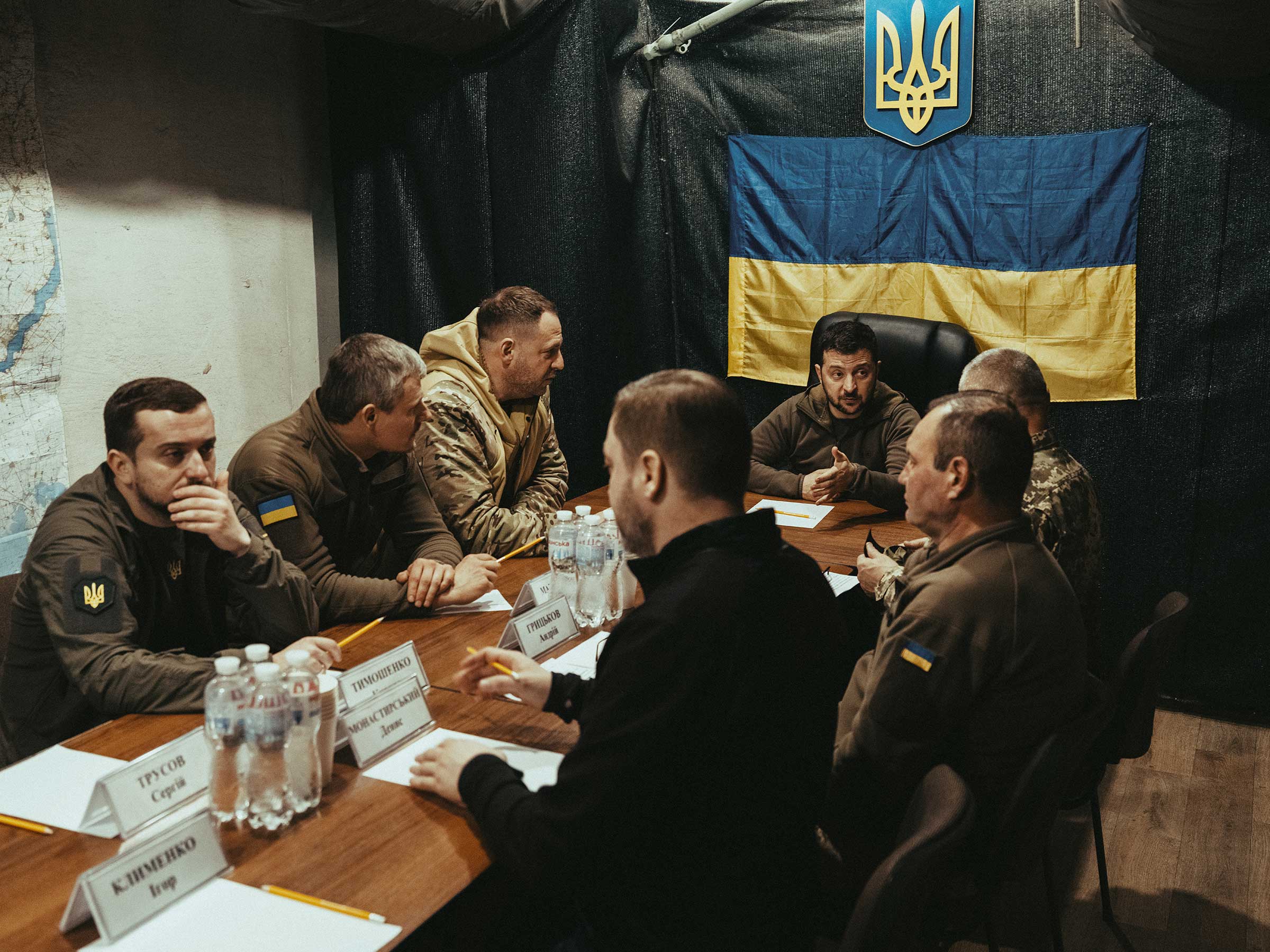
Zelensky has dialed into the World Economic Forum in Davos and the NATO summit in Madrid. He has granted interviews to talk-show hosts and journalists and held live chats with students at Stanford, Harvard, and Yale. He has leveraged the fame of entertainment superstars to amplify his calls for international support. Jessica Chastain and Ben Stiller visited his fortified compound. Liev Schreiber agreed to become an ambassador for Ukraine’s official fundraising platform. Sean Penn brought an Oscar statuette to Kyiv and left it with Zelensky. Once, the President allowed a team of technicians to create a 3D hologram of his likeness, which was later projected at conferences around Europe. “Our principle is simple,” says Andriy Yermak, the President’s chief of staff. “If we fall out of focus, we are in danger.” The attention of the world serves as a shield.
The effect has been a kind of virtual omnipresence that has at times grown tedious for some of Zelensky’s own citizens. “We’re always looking for new formats,” says Kyrylo Tymoshenko, the presidential adviser who oversees the TV marathon beaming Zelensky’s message into Ukrainian homes. “But sooner or later people get tired of the flood of news.” And they have started tuning out.
The liberation of Kherson gave the nation a rare chance to celebrate. A crowd had gathered in the center of the square, and someone shouted, “Glory to Ukraine!” The response was a chorus, mostly of women’s voices: “Glory to the heroes!” To the frustration of his security, Zelensky went over to greet them, and the throng surged forward as he approached. Reporters rushed up from behind, locking the President in a crush that his guards could not control. One soldier, his back to the President, had terror in his eyes as he scanned the faces in the crowd for threats. Zelensky smiled and waved. “How are you?” he said. “You alright?”
Buy a print of TIME’s Person of the Year, featuring Volodymyr Zelensky and the Spirit of Ukraine
Zelensky’s success as a wartime leader has relied on the fact that courage is contagious. It spread through Ukraine’s political leadership in the first days of the invasion, as everyone realized the President had stuck around. If that seems like a natural thing for a leader to do in a crisis, consider historical precedent. Only six months earlier, the President of Afghanistan, Ashraf Ghani—a far more experienced leader than Zelensky—fled his capital as Taliban forces approached. In 2014, one of Zelensky’s predecessors, Viktor Yanukovych, ran away from Kyiv as protesters closed in on his residence; he still lives in Russia today. Early in the Second World War, the leaders of Albania, Belgium, Czechoslovakia, Greece, Poland, the Netherlands, Norway, and Yugoslavia, among others, fled the advance of the German Wehrmacht and lived out the war in exile.
There wasn’t much in Zelensky’s biography to predict his willingness to stand and fight. He had never served in the military or shown much interest in its affairs. He had only been President since April 2019. His professional instincts derived from a lifetime as an actor on the stage, a specialist in improv comedy, and a producer in the movie business.
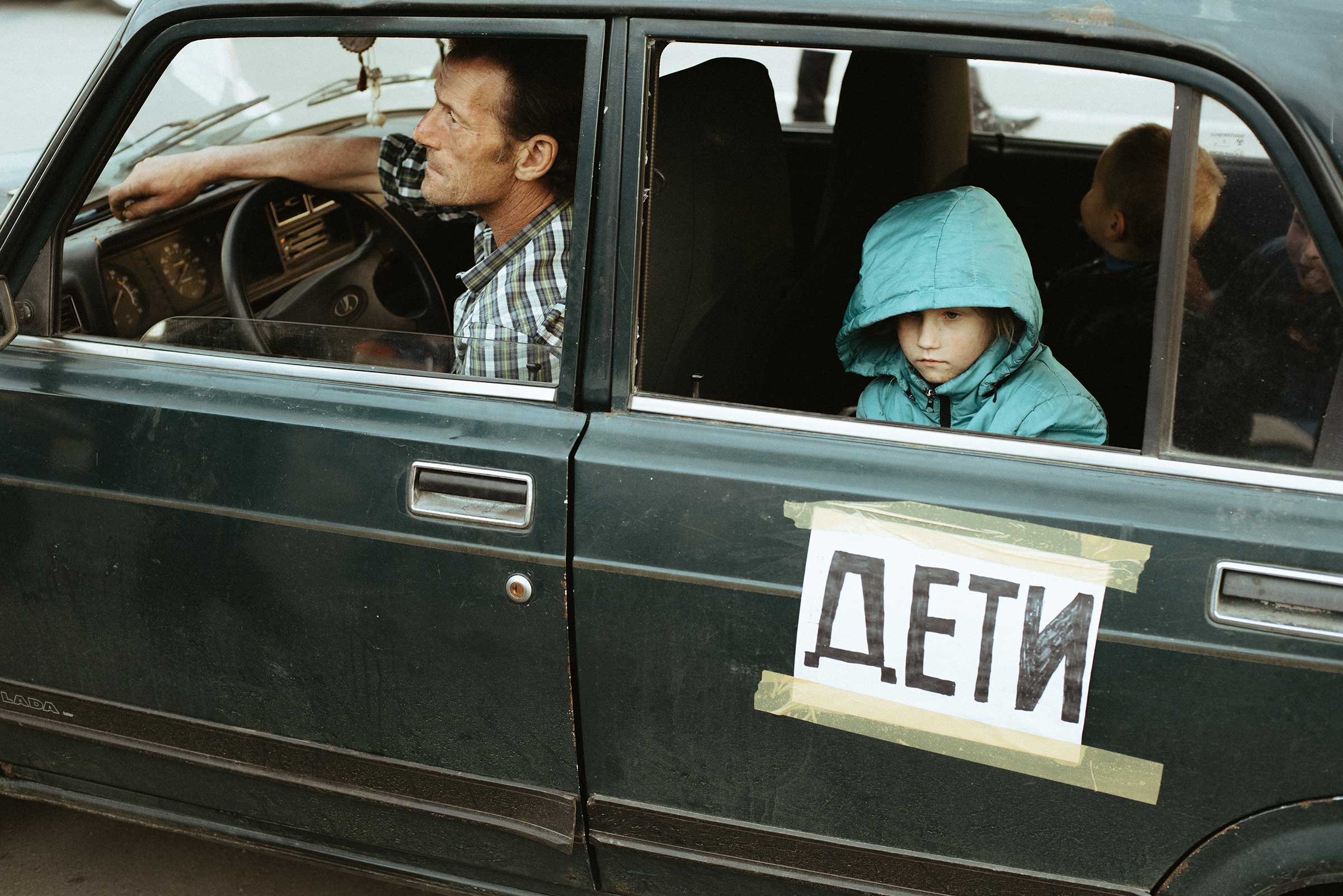

That experience turned out to have its advantages. Zelensky was adaptable, trained not to lose his nerve under pressure. He knew how to read a crowd and react to its moods and expectations. Now his audience was the world. He was determined not to let them down. His decision to stay at the compound in the face of possible assassination set an example, making it more difficult for his underlings to cut and run. “Anyone who left is a traitor,” Ruslan Stefanchuk, the speaker of Ukraine’s parliament, told its members a few hours after the invasion started.
Instead of running for their lives, many Ukrainians grabbed whatever weapons they could find and ran to defend their towns and cities against an invading force armed with tanks and attack helicopters. “Military theory does not account for regular dudes with track pants and hunting rifles,” Ukraine’s top military commander, General Valeriy Zaluzhny, told me in describing the defense of Kyiv during the invasion’s first weeks.
How much credit does Zelensky deserve for that defense? In the early hours of the invasion, the President was informed that Russia was attempting to fly thousands of troops to the gates of Kyiv in military cargo planes, and he gave orders to stop those planes from landing at any cost. One of his advisers, Mikhailo Podolyak, had never seen his boss that furious. “He gave the harshest possible orders: Show no mercy. Use all available weapons.”
But the armed forces of Ukraine did not need special dispensation to defend the airport where the Russian planes were headed. The machinery of Ukraine’s resistance was already in motion, and Zelensky was not at the wheel. He had spent months downplaying the risk of a full-scale invasion, even as U.S. intelligence agencies warned that it was imminent. When it started, he gave his generals the freedom to lead on the battlefield, and focused instead on the dimension of the war where he could be most effective: persuading the world that Ukraine must win at any cost. “Do prove that you are with us,” he said in a speech to the European Parliament in the first week of the invasion. “Do prove that you will not let us go. Do prove that you are indeed Europeans, and then life will win over death, and light will win over darkness.”
From Kherson’s central square, the presidential convoy headed out of the city, making stops along the way to honor and acknowledge its defenders. The first was a ceremony where Zelensky handed out medals to a few dozen soldiers, including at least one American volunteer who had participated in the city’s liberation. Another was a warehouse converted into a hub for humanitarian aid, piled high with boxes of canned fish, toilet paper, vegetable oil, and spaghetti. The workers went about their business as Zelensky looked around. One man at the wheel of a forklift seemed annoyed when the presidential entourage got in his way, and the machine beeped loudly as we tried to maneuver around him.
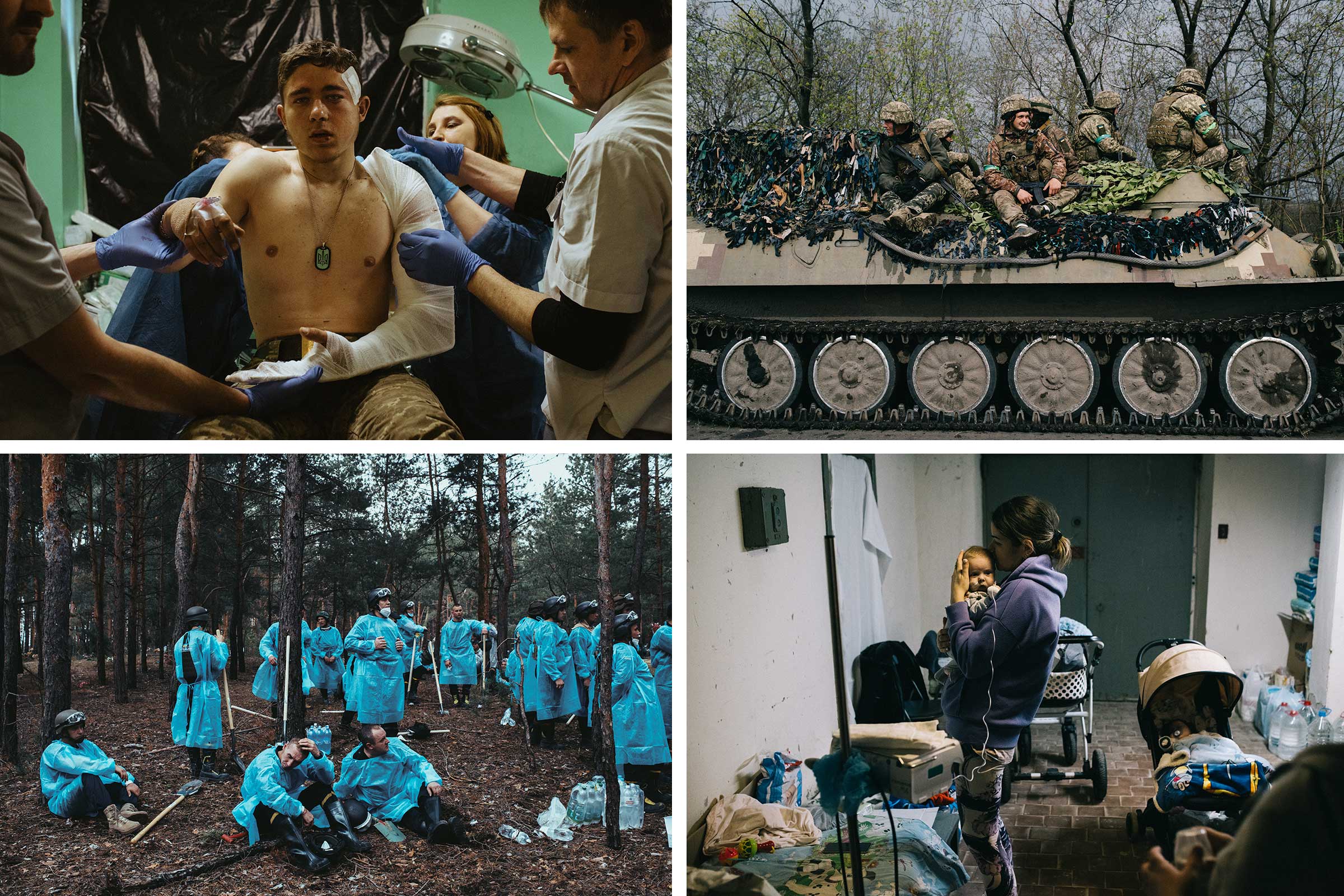
The reception was not much grander at the final stop on the agenda, a meeting with the military command in their bomb-proof bunker. It was hidden beneath an old machine works, accessible through a heavy metal door. A dark corridor brought us to a space packed with the bunk beds of soldiers and officers. One of them continued napping through most of our visit, then sat up in bed, pulled his uniform over his long johns, and went back to work. No one stood at attention or saluted the visiting commander in chief. In the mess hall, lunch was served in plastic bowls and paper cups: rice with ragù, sausage soup with day-old bread. Kherson remains a city at war. That morning, the Ukrainians had spotted a Russian surveillance drone hovering over the President. It was watching him, and they were watching it. Ukrainian security services are actively hunting Russian agents. “They live among us,” Zelensky told me. “In apartments, in basements, among the civilians, and we have to expose them, because that’s a major risk.”
After his meal, Zelensky walked to the other side of the bunker, where officers had prepared a military briefing. Everyone was asked to leave their phones at the door of the conference room. Inside a battle map hung on the wall, showing how the invaders had positioned themselves behind two dangerous obstacles, which they now intended to use as shields. To advance from the west, the Ukrainians would need to cross the Dnipro under a likely hail of artillery and machine-gun fire. To advance from the north, they would run into Ukraine’s largest nuclear power plant, which the Russians had occupied in early March. Its reactors now stand on the front lines, and Zelensky understood that pushing forward around that area would risk catastrophe. He had to consider what the Russians, in retreat, might do with those reactors.

Such questions are no longer foreign to Zelensky. He has been grappling with them for months, developing ways to structure his thoughts around dilemmas that might once have overwhelmed him. “There used to be this lightweight quality to him,” one of his military advisers, Oleksiy Arestovych, told me. “Quick movements, quick decisions, lots of talking, jokes. Now you see a kind of bruiser,” he says, narrowing his eyes and pushing his shoulders forward in imitation. “He’s lost that actorly quality, and he’s turned into a boss.”
When it comes to battlefield decisions, Zelensky usually focuses on human lives—how many would be lost if we take this path? “We could have pushed into Kherson earlier, with greater force. But we understood how many people would have fallen,” he says. “That’s why a different tactic was chosen, and thank God it worked. I don’t think it was some genius move on our part. It was reason winning out, wisdom winning out against speed and ambition.”
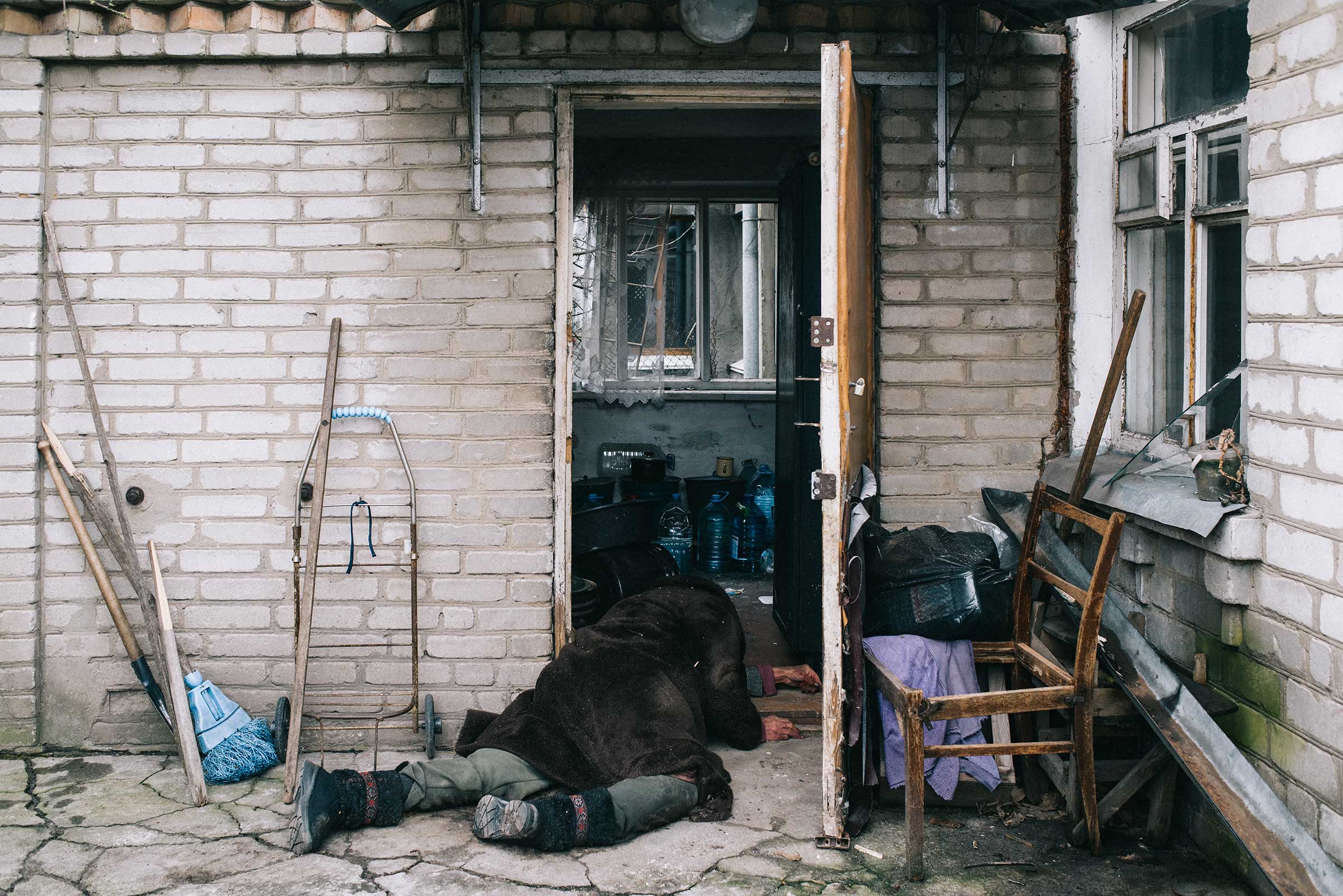

The sun was close to setting by the time we got back to the train. Its locomotive idled at a distance from the nearest station. On normal days—if any wartime days can be considered normal—Zelensky and his staff are in a perpetual hurry. They speak to each other in bursts of information, status reports, and military briefings, jumping from one agenda item to the next. The routine slows when they are traveling. The train creeps along at a dreary pace on purpose. In case of a rocket strike on one of the wagons, the others would sustain less damage at that speed, and more passengers would be likely to survive. “It gives us a chance to speak in peace,” says Denys Monastyrsky, the Minister of Interior, who has accompanied the President on some of his trips. “We talk about our private worries, our families, our kids.”
For most of this year, Zelensky lived apart from his wife and their two children. The main reason is security; his presence would put them at greater risk. But he also feels it would be wrong to resume their domestic habits while so many Ukrainian families remain separated by the war. Millions of refugees from Ukraine are living abroad, mostly women and children, while men of fighting age are prohibited from leaving the country without special permission, which is not granted readily under the terms of martial law.
Still, Zelensky sees his family much more often now than in the first weeks of the war. During a recent visit, his 9-year-old son, Kyrylo, surprised his father with his expertise in military matters. Zelensky seemed proud of the boy’s new interests. “He studies it all. He looks it up online. He talks to the bodyguards,” the President told me. “He’s a fan of our armed forces, our army, and he knows deeply what our mission is, what we’re liberating, what weapons we have and what we’re missing.”
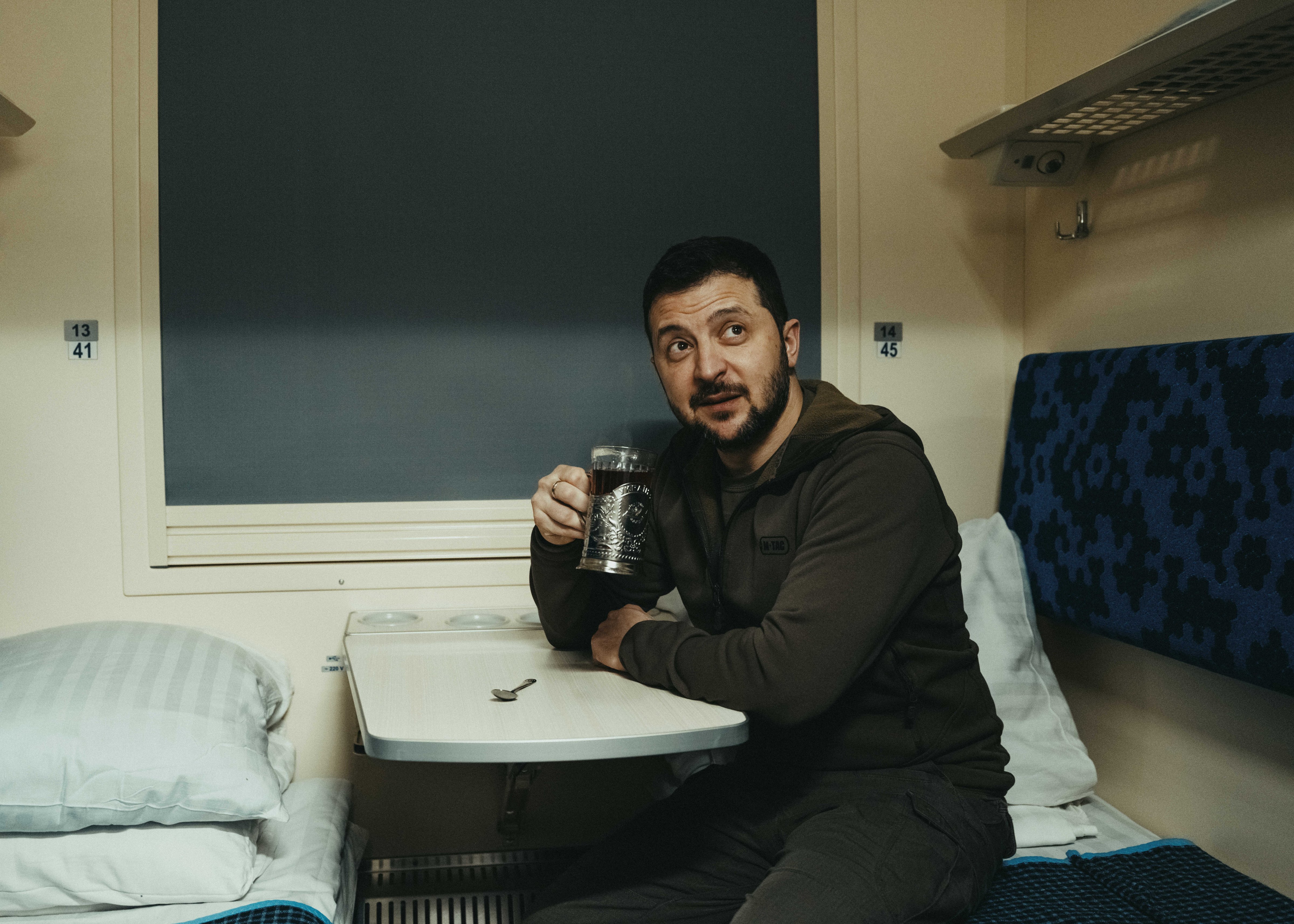
As the train started moving back toward Kyiv, Zelensky asked me to join him in his private carriage. The blinds were closed. A narrow sofa stood against one wall, and a swirl of documents covered a conference table. It would be our fifth interview since he decided to run for President in 2019, and the impact of that decision was written on his features. His face has a careworn quality now, with fatigue and layers of pain around the eyes.
Sitting across from me, Zelensky ordered coffee, picked up a paperback book, and looked it over. It was about the lives of Hitler and Stalin during World War II, a comparative study of the two tyrants who had tormented Ukraine the most. Zelensky had not had time to read it yet, but such works of history and biography have long been among his travel companions. Before he decided to run for President, Zelensky had devoured a book about Lee Kuan Yew, the founding father of Singapore, whose brutal war against corruption has earned him renown and respect in Ukraine. Zelensky has been accused by critics of exhibiting some of the same authoritarian tendencies, stripping the power of the oligarchs and seeking to imprison political opponents whom he considers treasonous.
Since taking office, Zelensky has read about Winston Churchill, the historical figure to whom he has most often been compared in recent months. Yet he recoils at the suggestion that they have anything in common. “People say different things about him,” Zelensky notes dryly, making clear that he has no admiration for Churchill’s record as an imperialist. Ukraine’s President would prefer to be associated with other figures of Churchill’s era, like the author George Orwell, or with the great comedian who lampooned Hitler in the middle of the Holocaust. “I’ve raised the example of Charlie Chaplin,” Zelensky told me on the train, “how he used the weapon of information during the Second World War to fight against fascism. You see, there were these artists who helped society, because they had a lot of admirers, and their influence was often stronger than artillery.”
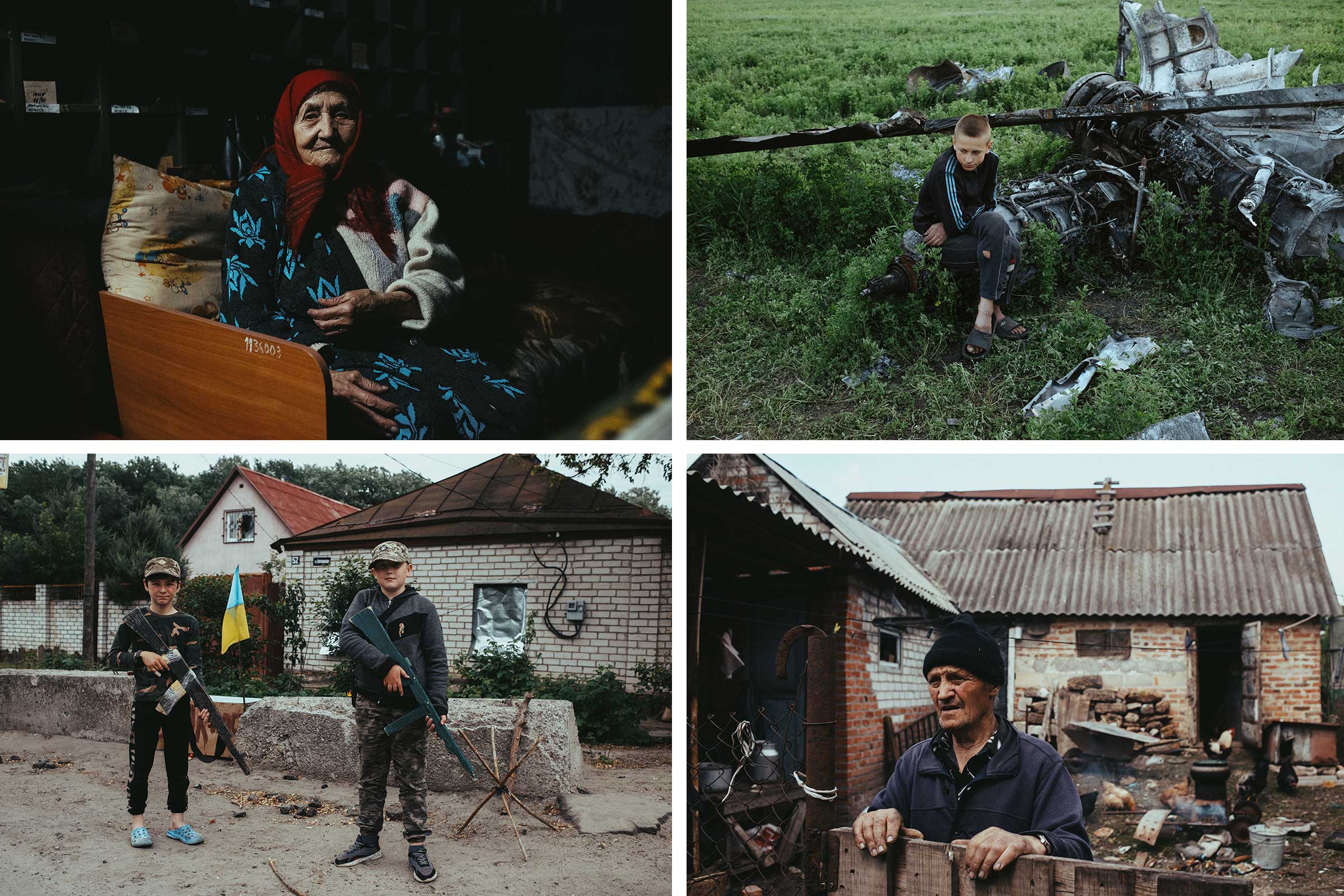
As the train moved out of the battlefield regions and picked up a bit of speed, it became clear that Zelensky seeks much more than battlefield victories. What he wants to achieve during his tenure is to break the cycle of oppression and tragedy in which Ukraine has been trapped for generations. During his childhood, Zelensky’s grandmother would talk about the time when Soviet soldiers came to confiscate the food grown in Ukraine, its vast harvests of grain and wheat, all carted away at gunpoint. It was part of the Kremlin’s attempt, in the early 1930s, to remake Soviet society, and it led to a catastrophic famine known as the Holodomor—“murder by hunger”—that killed at least 3 million people in Ukraine.
This topic was taboo in Soviet schools, including those where both of Zelensky’s grandmothers worked as teachers. One taught the Ukrainian language; the other taught Russian. But they would mention the history of the famine at home. “They talked about it very carefully,” he says, “that there was this period when the state took away everything, all the food.” That these policies resulted in the death of millions only became widely acknowledged across Ukraine in the 1990s, when Zelensky was in high school. “We would find these things when the internet appeared,” he says. “The world became more open, and we began to learn.”
The topic of the Holocaust was discussed much more openly and frequently in Zelensky’s home. Both of his parents are Jewish. His mother’s side of the family survived the war in large part because some of them were evacuated by train to Uzbekistan as the German occupation of Ukraine began. Many of Zelensky’s relatives on his father’s side were murdered by the Nazis. His paternal grandfather, an artilleryman in the Soviet army, lost his parents and three of his brothers in the Holocaust. “These tragedies came one after the other, first the Holodomor, then World War II,” Zelensky says. “One tremendous blow followed the next.”


I asked whether this history had in some ways hardened Ukraine as a nation, contributing to its resolve in fighting the present war. The question earned me a piercing look. “Some people might say it hardened us. But I think it took away so much of Ukraine’s ability to develop,” Zelensky says. “It was one blow after another, the hardest kind. How does that harden us? People barely survived. Hunger broke them. It broke their psyches, and of course that leaves a trace.”
Now it was his generation’s turn to face the blows of a foreign invader. Instead of Stalin and Hitler, it was Putin trying to break their will by depriving them of heat and light, destroying their ability to harvest food, or to think about much besides survival through this winter. Already the next generation of Ukrainians, like Zelensky’s own son, were learning about the tools of war instead of planning for prosperity. That is the pattern the President aims to disrupt, and his plan relies on more than weapons.
“I don’t want to weigh who has more tanks and armies,” he says. Russia is a nuclear superpower. No matter how many times its forces are made to retreat from Ukrainian cities, they can regroup and try again. “We are dealing with a powerful state that is pathologically unwilling to let Ukraine go,” Zelensky told me. “They see the democracy and freedom of Ukraine as a question of their own survival.” The only way to defeat an enemy like that—not just to win a temporary truce, but to win the war— is to persuade the rest of the free world to pull Ukraine in the other direction, toward sovereignty, independence, and peace. The loss of freedom in one nation, he argues, erodes freedom in all the rest. “If they devour us, the sun in your sky will get dimmer.”
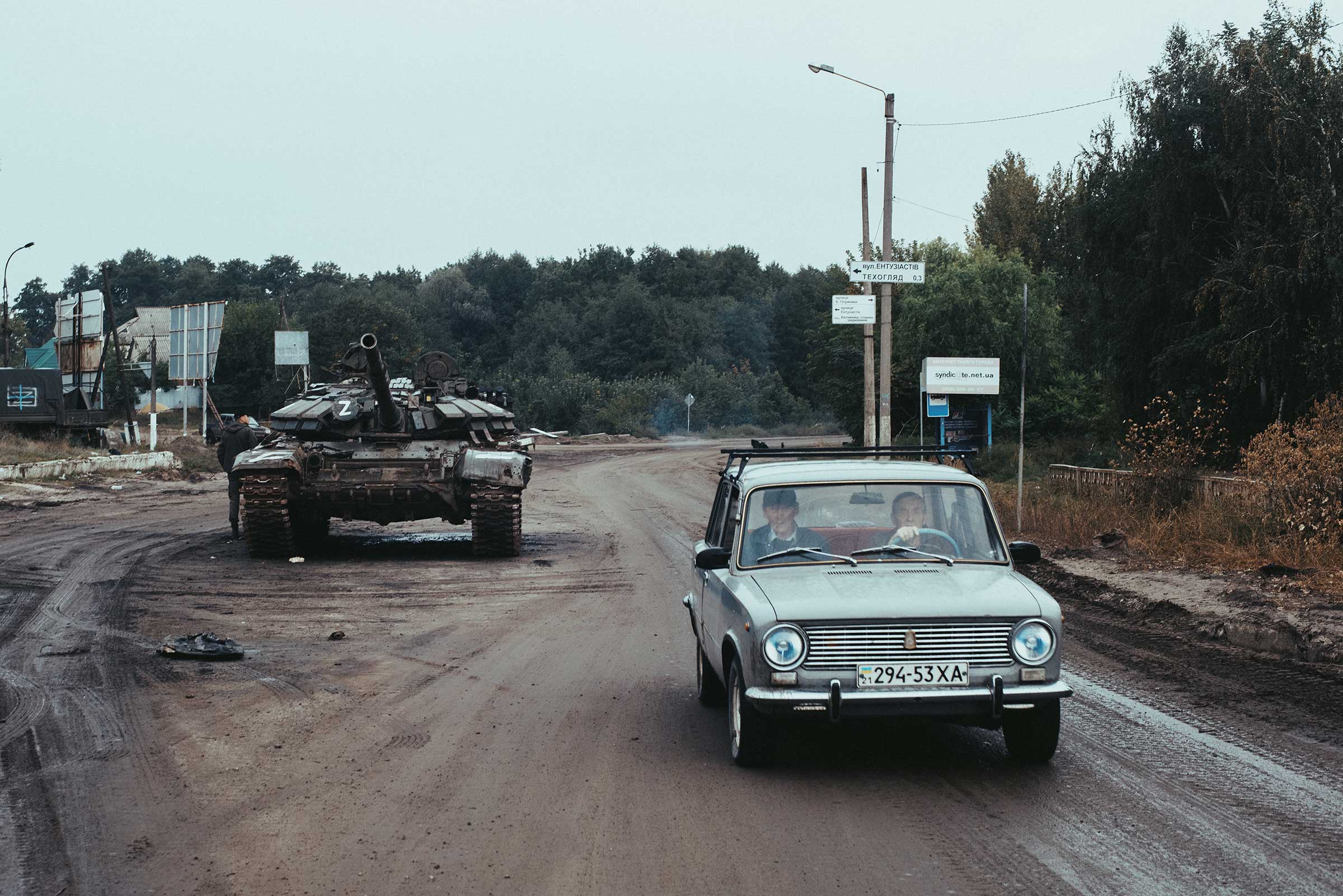
It was approaching midnight when we arrived back in Kyiv. The President’s carriage stopped next to a gap in a concrete wall, behind which another convoy of cars was waiting to take him back to his office. Before dawn, Zelensky was due to give a speech to the G-20 summit in Bali, where the war in Ukraine topped the agenda. Despite the role that Russia plays in the group, its envoys were being ostracized by many of their peers in Bali, and its Foreign Minister, Sergey Lavrov, had decided to go home early. “The Russians need to understand,” Zelensky told me. “They will have no forgiveness. They will have no acceptance in the world.”
Just before 3 a.m., Zelensky took his seat in the Situation Room on the second floor of the presidential compound. A golden trident, the state symbol of Ukraine, hung on the wall behind him. He was dressed in his usual olive green T-shirt when the cameras turned on. “Greetings,” he said, “to the world’s majority, which is with us.”
The battle to liberate Kherson was over, he announced, and it was reminiscent of history’s great military victories, like the Allied landing at Normandy on D-Day, which turned the tide of World War II. “That was not yet a final point in the fight against evil, but it already determined the further course of events. That is exactly what we are feeling now. Now, Kherson is free.”
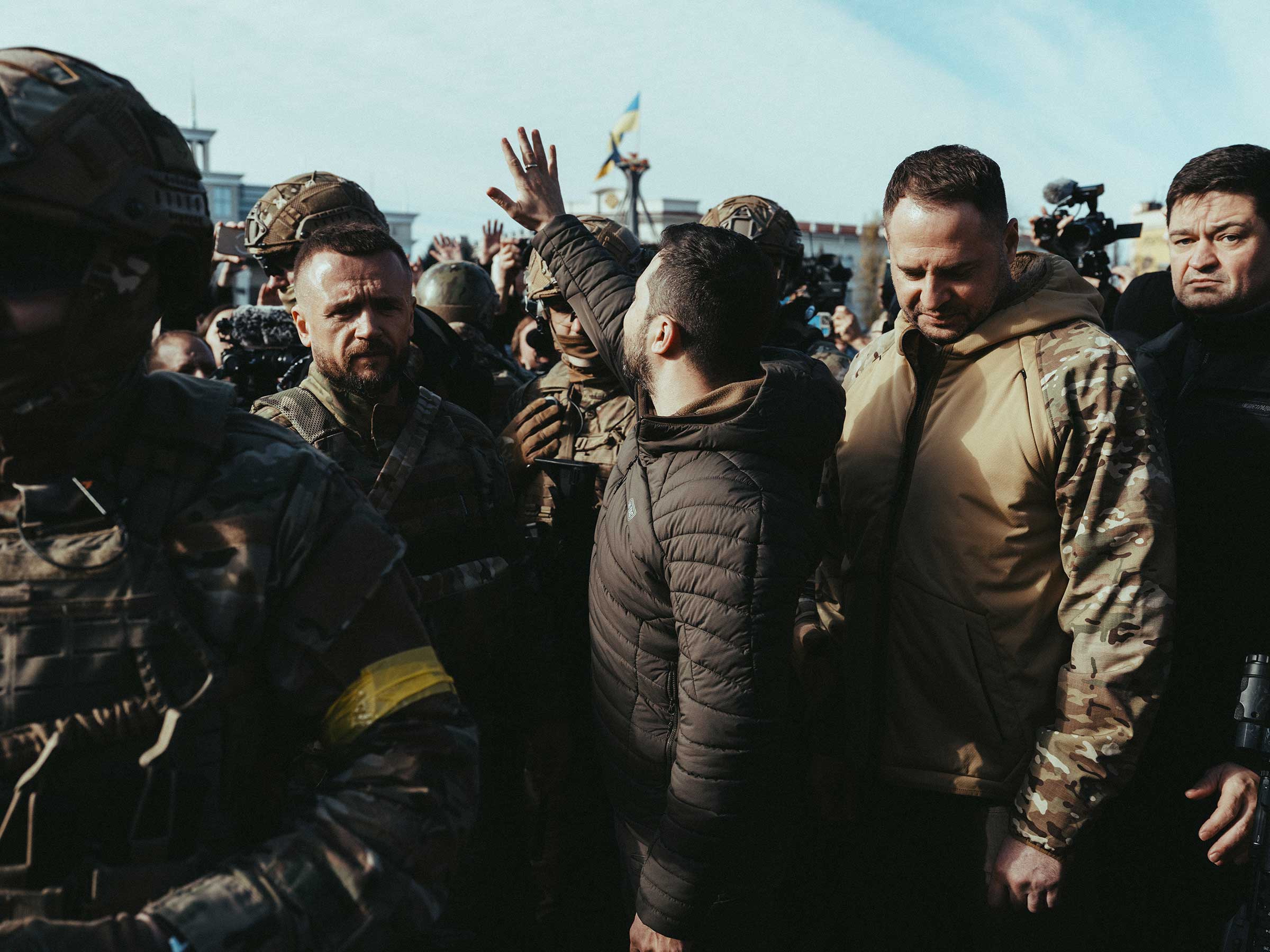
But his vision of victory now extends beyond the liberation of territory. In our interview on the way back from Kherson, Zelensky stressed that this year’s invasion is just the latest Russian attempt over the past century to subjugate Ukraine. His intention is to make it the last, even if it takes a lot more time and sacrifice. It is far too early to gauge whether that goal can be reached, Zelensky told me. “Later we will be judged,” he says. “I have not finished this great, important action for our country. Not yet.” —With reporting by Leslie Dickstein and Simmone Shah